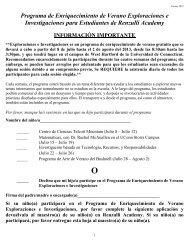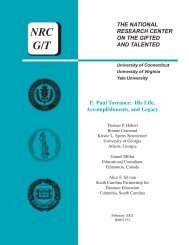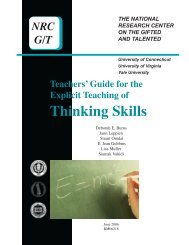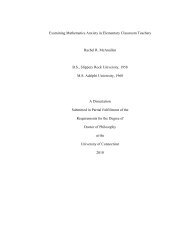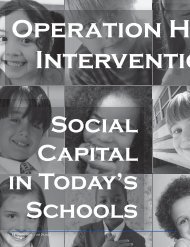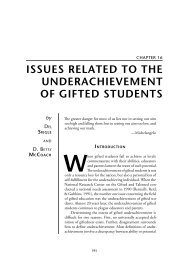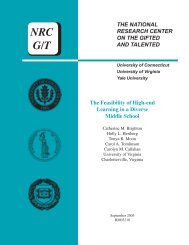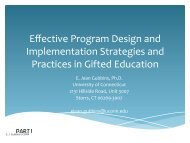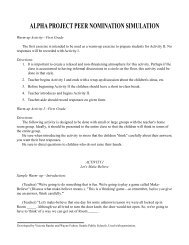Giftedness and High School Dropouts - Neag Center for Gifted ...
Giftedness and High School Dropouts - Neag Center for Gifted ...
Giftedness and High School Dropouts - Neag Center for Gifted ...
You also want an ePaper? Increase the reach of your titles
YUMPU automatically turns print PDFs into web optimized ePapers that Google loves.
15<br />
CHAPTER 3: Research Methods <strong>and</strong> Procedures<br />
In this chapter, the research methods <strong>and</strong> procedures are described. First, the<br />
survey design <strong>and</strong> data collection methods of the National Education Longitudinal Study<br />
of 1988 (NELS:88) data are described. Then, the research design, sample, <strong>and</strong> variables<br />
are reported. Finally, weights <strong>and</strong> st<strong>and</strong>ard error of the study are discussed.<br />
National Education Longitudinal Study of 1988 (NELS:88)<br />
To survey high school students' experiences <strong>and</strong> per<strong>for</strong>mance in 1970s, 1980s,<br />
<strong>and</strong> 1990s, three longitudinal studies have been conducted by NCES: The National<br />
Longitudinal Study of the <strong>High</strong> <strong>School</strong> Class of 1972 (NLS-72); <strong>High</strong> <strong>School</strong> <strong>and</strong><br />
Beyond (HS&B); <strong>and</strong> the National Education Longitudinal Study of 1988 (NELS:88).<br />
The NELS:88, the most recent longitudinal study, began in 1988 by collecting data on<br />
approximately 25,000 eighth grade students, including data from their parents, teachers,<br />
<strong>and</strong> school administrators, which was then followed up at 2-year intervals in 1990, 1992,<br />
<strong>and</strong> 1994.<br />
In the base year (1988), a two-stage, stratified sample design was used to collect<br />
the NELS:88 data. In the first stage, as a primary sampling unit, 1,032 schools were<br />
proportionally selected according to their estimated eighth grade enrollment. By<br />
excluding ineligible schools <strong>and</strong> including additional schools, a total of 1,052 schools<br />
(815 public <strong>and</strong> 237 private) of 39,000 schools with eighth graders were finally selected<br />
(National <strong>Center</strong> <strong>for</strong> Education Statistics, 1994a). In the second stage, 24,599 eighth<br />
grade students were selected. Students completed a self-administered questionnaire <strong>and</strong> a<br />
cognitive test on reading, math, science, <strong>and</strong> history/citizenship/geography. The alpha<br />
reliabilities <strong>for</strong> these cognitive tests given in the base year were r=.84, .90, .75, <strong>and</strong> .83,<br />
respectively (National <strong>Center</strong> <strong>for</strong> Education Statistics, 1995). In the first follow-up<br />
(1990), students also completed a questionnaire <strong>and</strong> a cognitive test. In addition to this<br />
student questionnaire, a dropout questionnaire, including a wide range of personal <strong>and</strong><br />
educational subjects, was given to students who had dropped out of school between the<br />
spring term of the 1987-88 school year <strong>and</strong> the 1989-90 school year (National <strong>Center</strong> <strong>for</strong><br />
Education Statistics, 1994a).<br />
The second follow-up data, collected in 1992, included the same components as<br />
the first follow-up, plus the parents' questionnaire, students' transcripts, <strong>and</strong> course<br />
offering in<strong>for</strong>mation. In the second follow-up, a dropout questionnaire was given to the<br />
students who had dropped out of school at some point between the spring term of the<br />
1987-88 school year <strong>and</strong> the spring term of the 1991-92 school year. The questionnaire<br />
covered reasons <strong>for</strong> leaving school, school experiences, absenteeism, plans <strong>for</strong> the future,<br />
employment, attitudes, self-concept, <strong>and</strong> home environment. In addition, transcript data<br />
were collected on 17,000 students out of a target number of 21,188 individuals, including<br />
both high school seniors <strong>and</strong> dropouts. Data from the third follow-up were collected in<br />
1994, 2 years after the students graduated. Because most students had graduated from




